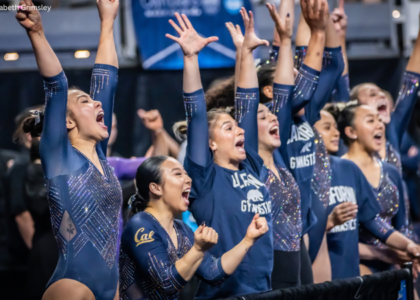If you’ve been following tweets from our trusty roster robot, Rudi, you’ll have noticed an uptick in additions over the past few weeks; it’s the January joinees we’ve all been waiting for—those who will join this year’s freshman class midway through the year. Three were surprisingly announced this week, including two international gymnasts: Mexico’s Jessica Gutierrez and Puerto Rico’s Bianca Léon will join Utah State and Southern Connecticut, respectively.
This flurry of activity got us thinking about past January additions and the impact on their teams. From what we could find, 19 gymnasts joined their teams as January enrollees between 2015 and 2019. They undoubtedly had a variety of reasons for joining midway through the year, but there tends to be one common thread: These gymnasts saw or have seen minimal competition time, and it tends to be concentrated on one or two events.
The most notable exception to this trend is Kentucky senior Mollie Korth. When she enrolled at Kentucky in January 2017, she hit the ground running as an immediate all around contributor. She’s competed all four events in all but one meet of her entire college career.
However, the fact that she’s even made it to her senior season is past the guarantee of most January enrollees. Five of the 19 we found were removed from their rosters before they graduated, and three saw only one season of competition. Of those who joined last January, only one competed more than two routines all year: Bailey Ferrer of LSU, who did bars at 13 meets. But Ferrer recently announced she’ll sit out her sophomore season, so add her to the list of those January joinees who went whole years without competing.
Obviously, there’s a lot the data doesn’t tell. Perhaps some of those who competed less, especially in their first season, were focusing on adjusting to college life and preserving their bodies while they could. However, it can’t be denied that these gymnasts see less competition time on the whole than their teammates who started their freshman year in the fall. That adjustment to college is difficult, and it can translate to mental blocks in the gym that could have been better worked through with a few months of preparation leading up to the season.
As for those January enrollees who remained limited their entire career, that’s harder to explain. Maybe they would have always been minor competitors. One could argue that, because of depth, Alex Marks wouldn’t have done more than vault and bars even if she had arrived at Oklahoma in the fall of her freshman year. But it’s also a question of whether that extra semester would have given her the time to further develop beam and floor so that she could have cracked those lineups, too.
January joinees will likely have a great time in college, regardless of how long or how much they compete. They’ll form close bonds with their teammates and enjoy the unmatched experience of being part of a college gymnastics team. For some, joining in January is the best option financially (it could guarantee a scholarship where a fall addition wouldn’t have), and for others, it relates to hometown ties (Sania Mitchell, an Alabama sophomore, is a Tuscaloosa product, and former Utah gymnast Lauren Wong came straight from Salt Lake City).
All that being said, when we say starting in January isn’t worth it, we mean only in the sense of competing consistently across over all four years. On those points, the data isn’t too promising, but we hope to be proven wrong as more gymnasts consider the January option. It’s a growing contingent: While there were only 19 January enrollees over the past five years, 2020 alone will bring 17 of them. As these gymnasts progress through their college careers, we’ll see if joining in January remains a sentence to a limited collegiate career or the chance to have a better time than they would have had otherwise.
To see our complete data set from 2015 to 2019, click here.
Article by Katherine Weaver
Like what you see? Consider donating to support our efforts throughout the year! [wpedon id=”13158″]




